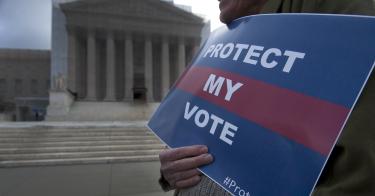One thing is crystal clear amid the contentious fights occurring over the outcome of the 2020 presidential election: predictions that certain states would "backslide" into discriminatory voter suppression following the Supreme Court's 2013 Shelby County v. Holder decision were completely wrong. Turnout in both presidential and congressional elections in those states has risen significantly since that decision.
When the Supreme Court handed down its ruling, the Shelby County decision was unjustly criticized and misunderstood by many who claimed the decision abrogated the Voting Rights Act. That claim was simply not true. The act's main provision—a permanent, nationwide ban on racial discrimination in the voting context—is alive and well today. It has been so effective that discriminatory practices by state and local officials have become a rare exception rather than the rule.
What was at stake in Shelby County was Section 5, an emergency provision passed in 1965 that was only supposed to last five years but was successively renewed by Congress. Under Section 5, certain jurisdictions could not make any changes to their voting laws without first getting the approval—referred to as "preclearance"—of the U.S. Justice Department or a federal court in Washington, D.C.
The coverage formula was designed to capture those states, and only those states, that were engaging in blatant discrimination. In determining which states would be covered by the preclearance requirement, Congress took into account the low registration and turnout caused by discriminatory practices. Specifically, it covered states that had maintained a test or device as a prerequisite to voting and had voter registration or turnout of less than 50 percent in the 1964, 1968, or 1972 presidential elections. Those states were Alabama, Alaska, Arizona, Georgia, Louisiana, Mississippi, South Carolina, Texas and Virginia.
No one disputed that Section 5 was needed in 1965, and hence the Court upheld its constitutionality because of the widespread and extensive discrimination in the segregationist South. But the majority rightly said in Shelby County that the preclearance requirement—an extraordinary intrusion into state sovereignty—was no longer constitutional because it had not been updated to reflect modern conditions.
In an opinion by Justice Ruth Bader Ginsburg, the four dissenting justices claimed that Section 5 was "vital to protecting minority rights" and predicted that without it, there would be "backsliding" by state and local governments returning to their old ways of discriminating. As several national elections have taken place since the decision, we can now evaluate whether Ginsburg's prediction was justified.
Since Congress thought voter turnout was an appropriate measure of discriminatory practices when it passed Section 5, it is still a relevant measure to show how wrong the dissenters were about what would happen without Section 5 in place. As the 2020 turnout numbers show, the dissenting justices were wrong to view these states through a lens that saw only the decades-old past. Turnout has generally gone up, not down, in all of the formerly covered states, sometimes beating the national average.
The United States Election Project (USEP) calculates turnout based on the Voting Eligible Population or VEP, which begins with the voting-age population of each state and subtracts individuals who are ineligible to vote, such as non-citizens and felons who have not yet had their ability to vote restored. The following numbers are the VEP turnout rate from USEP for the highest office on the ballot.
The national VEP turnout in the 2012 presidential election—before Shelby County—was 58 percent. The national VEP turnout in 2016—after Shelby County—was 59.2 percent. So turnout went up nationally that year and went up again in this year's election, which the USEP pegs at 66.6 percent.
The VEP turnout also either went up or stayed virtually the same in the nine formerly covered states. Alabama's turnout in 2012 was 58.6 percent; in 2016 it was 58.8 and in 2020 it was 63.1, steadily rising after Shelby County. Over the same three elections Georgia went from 59 to 59.1 to 67.7. Alaska from 52.6 to 54.9 to 68.8. Louisiana went from 60.2 to 60 to 64.4. Mississippi went from 59.3 to 55.2 to 60.2. South Carolina went from 56.3 to 56.7 to 60.4. Texas climbed steadily from 49.6 to 51.4 to 60.4. Even Virginia jumped from 66.1 in 2012 and 2016 to 73 this year. Note that all of these turnout rates are about or higher than Congress's key 50 percent measure.
Similar increases happened in congressional elections (which have much lower turnout) in the USEP numbers. For example, the VEP turnout in Alabama in 2014 was 32.9 percent, rising to 46.9 percent in 2018. Georgia, which has been the subject of many recent claims of voter suppression, went from 33.4 percent in 2014 to 46.9 percent in 2018, while Mississippi went from only 29 percent in 2014 to 42.7 percent in 2018.
There is no "voter suppression" epidemic in the U.S., contrary to the charges made by some. Such claims are a myth created to oppose any effort to implement common-sense reforms designed to improve the security and integrity of the election process, like requiring an ID to vote or ensuring that states maintain accurate, up-to-date voter-registration rolls. There is no need to reimpose Section 5 on states that left their discriminatory pasts behind—there has been no "backsliding."
This piece originally appeared in Newsweek




